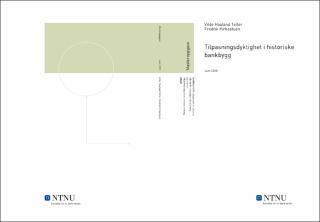| dc.contributor.advisor | Haugen, Tore Brandstveit | |
| dc.contributor.advisor | Lindkvist, Carmel Margaret | |
| dc.contributor.author | Kirkestuen, Fredrik | |
| dc.contributor.author | Teller, Vilde Haaland | |
| dc.date.accessioned | 2021-09-13T16:24:28Z | |
| dc.date.available | 2021-09-13T16:24:28Z | |
| dc.date.issued | 2020 | |
| dc.identifier | no.ntnu:inspera:61009049:45603798 | |
| dc.identifier.uri | https://hdl.handle.net/11250/2776164 | |
| dc.description.abstract | I dag er det et problem at historiske funksjonsbygg står tomme, som følger av at virksomheter ønsker nye arealer tilpasset deres behov. Selv om mange flytter fra sine eldre lokaler, vil fortsatt den historiske bygningsmassen utgjøre en stor ressurs for samfunnet, både økonomisk, men og med hensyn til klima.
Begrepet tilpasningsdyktighet beskriver hvor godt et bygg kan tilpasse seg ulike behov, basert på sine strukturelle egenskaper. Oppgavens problemstilling er: Er historiske bankbygg tilpasningsdyktige? Masteroppgaven undersøker tilpasningsdyktighet i historiske bankbygg i to ulike caser i Trondheim sentrum, basert på prosjektrapporten Generalitet, fleksibilitet og elastisitet i bygninger, av Kirsten Arge og Kikkan Landstad. Det presenteres relevant teori for å gi leseren innblikk i tilpasningsdyktighet i bygg og om vernet bebyggelse. Oppgaven er gjennomført i samarbeid med Sparebank 1 SMN og Danske Bank Trondheim. I tillegg til undersøkelse av tilpasningsdyktighet, er det gjennomført en «desk research» av bankbyggs historiske utvikling. Denne delen plasserer casebyggene i et historisk perspektiv.
Konklusjonen viser at det er få fysiske egenskaper i de historiske bankbyggene som er bygd med øye for tilpasningsdyktighet. Likevel velger bankene å bruke byggene i dag, til tross for begrensningene de gir. I begge case uttrykker brukerne at historien til banken kan representeres gjennom byggene. Det er forøvrig også felles for begge case at det blitt bygd et tilbygg til det originale historiske bankbygget. Tilbyggene utfyller de behovene virksomhetene har, som det historiske bygget ikke tilfredsstiller. | |
| dc.description.abstract | Today, many historic buildings are empty, as companies choose to move to new buildings better suited to their needs. Although this happens, the historic building stock will still be a great resource for the community, in terms of both economic gain, but also in terms of environmental gain for the future.
The term adaptability describes how well a building can adapt to a changing set of needs, based on the building’s structural traits. The chosen problem statement is: Are historic bank buildings adaptive? The thesis explores adaptability in two case buildings in the city centre of Trondheim, and is based on the report Generalitet, fleksibilitet og elastisitet i bygninger, written by Kirsten Arge and Kikkan Landstad. Relevant theory is presented to give the reader an insight into adaptability of buildings and legislation related to listed buildings.The thesis has been carried out in collaboration with Sparebank 1 SMN and Danske Bank Trondheim. In addition to exploring adaptability, there has been conducted a «desk research», on the historic development of bank buildings. This section places the case buildings in a historic viewpoint.
The conclusion is that there are few physical features in the historic case buildings that have been built with adaptability in mind. Nevertheless, the banks choose to use these buildings today, despite their limitations. Both users express that they want to represent their history through their historic buildings. Another common feature for both cases is that an extension to the original historic bank building has been built. These extensions fulfill the needs of the businesses, in which the historic buildings are not able to. | |
| dc.language | | |
| dc.publisher | NTNU | |
| dc.title | Tilpasningsdyktighet i historiske bankbygg | |
| dc.type | Master thesis | |
